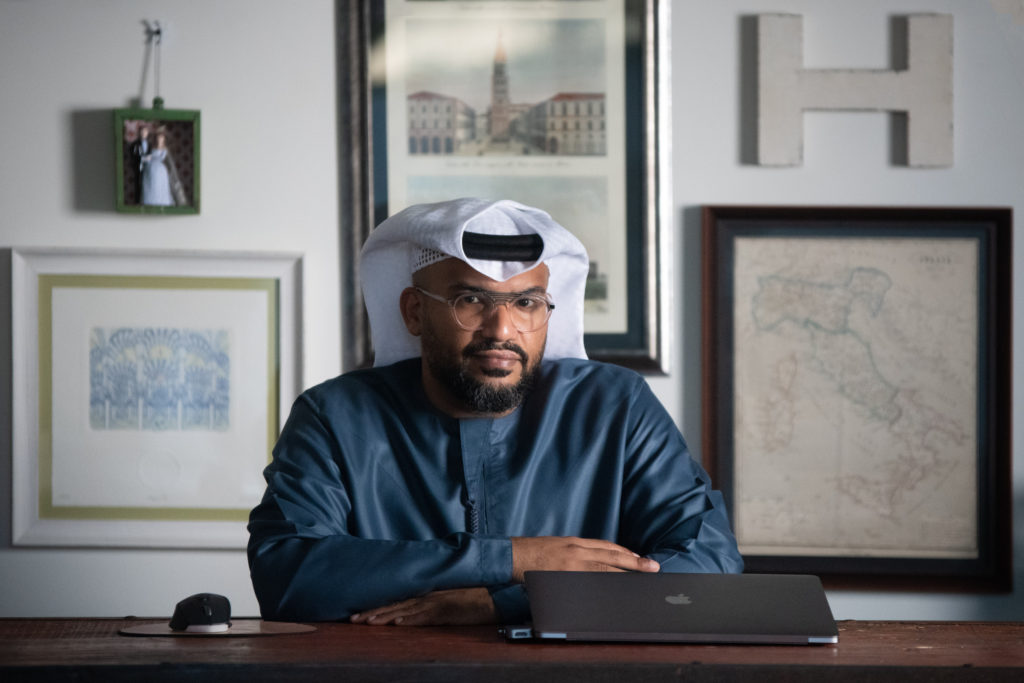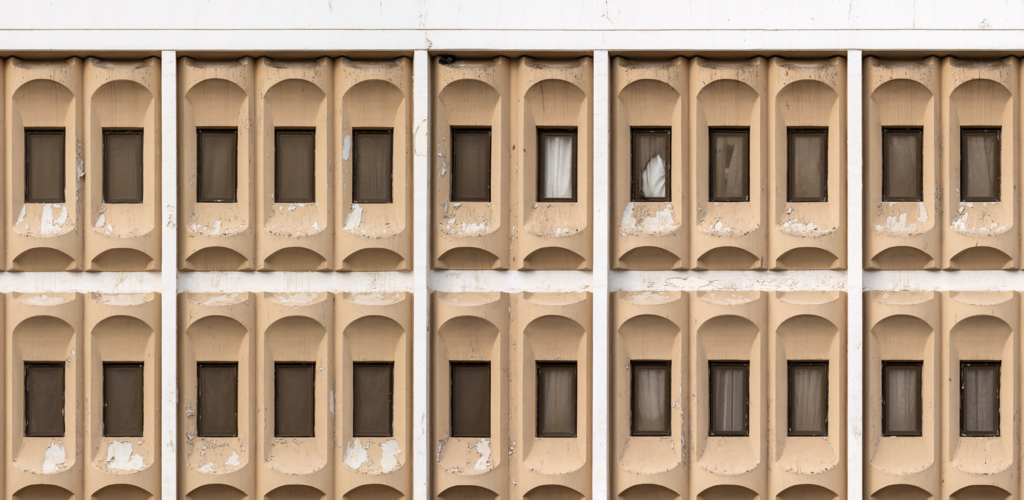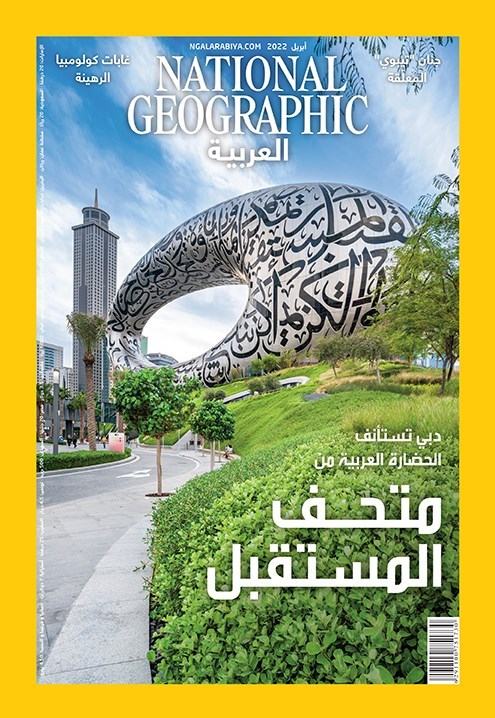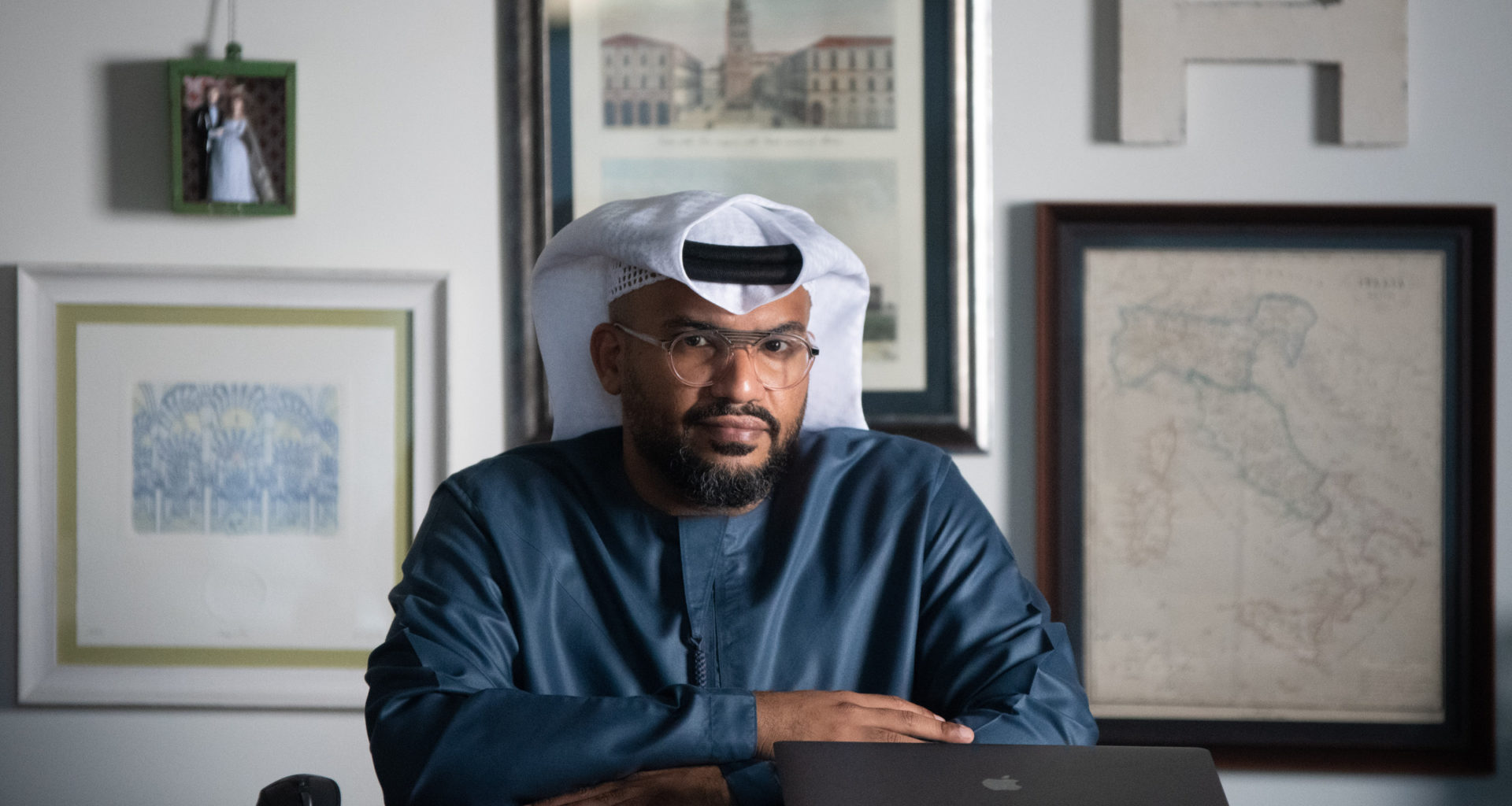It was my first time visiting the Museum of the Future in Dubai and it so happened that Hussain and his team were conducting assignments to feature the iconic building on the cover of National Geographic Al Arabiya. He explored different vantage points of the building from the ground up. Each perspective provides different results, as he recalled a lesson from a standup comedy he watched in Australia* which was to never settle for the first sight of anything. Capturing the right moment or angle requires plenty of trial and error.
Hussain AlMoosawi is an Emirati multidisciplinary creative with 15 years of experience in the realms of design, photography, and visual journalism. Trained in Australia and currently based in Abu Dhabi, he worked as an infographic artist at The National newspaper for four years, where he was responsible for generating its infographic content across print and digital platforms. Initially in January 2021, he led the creative team at Mohtawa, before acting as Editor-in-Chief of National Geographic AlArabiya Magazine in January 2022.
Through this interview, he reflected on how his skills have developed overtime during his long years of experience accumulated starting as a trainee onto the managerial role he holds today.

Educational journey & post-graduate career
Marsya Abdulghani: We are doing a retrospective of your career development since your undergraduate or master's degree to understand the creative and artistic development that led to where you are today. You're obviously a multi-talented person with a wide range of skill sets. How has your education, both formal and informal including any continuing education, led to where you are today?
Hussain Al Moosawi: Many acquired skill-sets such as creative writing in high school or photography during my undergraduate degree did not seem important at some point. Though I believe nothing goes to waste, as I will explain later how these skills became handy at different stages of my career.
My Higher Diploma in Applied Media widened my horizon as it included a bit of everything, where I learned the basics of video production, journalism, multimedia, photography and graphic design. Abroad, I specialized in Communication Design (a more generalized field that incorporates graphic design), graduating from Queensland College of Art in 2007. Completing a degree in design meant studying art history and art movements, which was very helpful in adding depth to my practice. Beyond formal training, my personal interest in photography started when I purchased a digital SLR camera in 2005. The tool became part of my social life. I took my camera everywhere. As designers, we tend to pick certain details that others don’t, and digital photography was a practical tool for documentation. I always tell people: l see the world as a designer and document as a professional photographer. Designers are good at capturing elements such as lines, typography, composition and alignment. However, to properly capture what you see, you need to have a good understanding of light. To my observation, many designers don’t understand light. My practice is a mesh between my formal education in design and my technical training in photography.
After graduating with my degree, my initial training in Brisbane included a strong element of branding. After that, I went to Melbourne to complete my masters in the same field. Returning to the UAE in 2013, I worked for The National newspaper, which I found very exciting because I combined two of my interests, media and design. Moreover, my role as an infographic artist also reflected one of the key disciplines I’ve undergone in my masters, which is data visualization. At this stage it felt as if I’m making a full circle by practicing several skills I’ve gathered through the years.
MA: How did the city of Melbourne shape the way you see the world?
HA: I feel extremely lucky to have lived in Melbourne. The third factor that contributed to my photographic practice (beside design and photography) was the city of Melbourne. If I have never lived there, my practice could have taken a different path. From then on, my quest as a photographer was to deconstruct the urban space around me. All what I photographed was part of a typology I was documenting over a period of a year. Studying those subjects aided my knowledge and oriented my perception of where I lived. It’s almost like having this kind of bug in my head. If something doesn't make sense to me, I photograph it to understand it. That’s my process.
MA: Can you elaborate on this process?
HA: Initially, I relied on mapping and walking areas street by street. I do the same here in the UAE, though given the subject matter such as facades are dispersed, I tend to drive instead. It’s not as fun as walking, but it ensures that I find a number of interesting subjects that I can collate into a typology. The other crucial factor is consistency. I photograph all my subjects from a consistent vantage point and during the same weather conditions. I follow a clear objective and methodology that’s not clouded by emotional judgements.
MA: Can you list three technical tools you cannot live without?
HA: For my photography, it would be a mapping app that would show me the position of the sun at different times of the day. For storytelling, it would be any storyboarding tool that helps me draft a sequence. I use artboards in Photoshop. The third tool would be anything that helps me test the outcome such as a testing account on Instagram.

Analytics in social media platforms
MA: Has your next job required additional skill-sets?
HA: I was looking for a purely digital role and this is exactly what happened. It was still within Abu Dhabi Media and it involved servicing an array of brands. Though, I had to get used to not having editors helping me prepare content. This is when I wore the content creator hat and started to think of the digital user experience. Initially, I worked on summarizing articles and presented them in a visually storytelling fashion on social media. This helped users obtain an article’s main takeaways and gave them the chance to click/swipe for more. On one hand, this offered a new user experience and equally, created a higher engagement rate that justified the time spent creating such content. I would say the two skills I had to revive were writing and user experience. Once I’ve established my approach, I trained team members in delivering this product and focused on original content creation that involved a key research component. At a technical level, I had to work with animators to make this content interactive. It was a fun process.
Pitching ideas
MA: Pitching is the starting point for any project. What is your approach when it comes to pitching?
HA: Storytelling. You really want people to enjoy the process of being pitched to. I imagine it like taking the stage in a theater. You need to make the audience smile, think deep, or possibly provoke them. You need to stir an emotion. Equally, you should not make them stuck with a visual, but rather a concept. That’s why choosing words carefully is important when pitching, as they help you imagine what you want to achieve. Visuals need to complement and persuade, but never attempt to illustrate a final image of the outcome. Otherwise, people will be stuck with what you show them. I owe this knowledge to my creative director at The Letter D, Dan Pike. The studio specialized in branding but the knowledge I gathered aided my multidisciplinary career.
MA: Do you provide any informational backings in your pitching process?
HA: Storytelling sparks an imagination and establishes a connection, though this isn’t sufficient sometimes to sell an idea. At this point you must think, what makes an idea convincing to yourself to begin with? Our confidence in an idea is sometimes stemmed from something we know but it’s hiding somewhere in the back of our heads. You need to somehow identify that key selling point and present it in a clear fashion. If the deliverable is digital, it’s no brainer to use analytics – though without oversharing data. You only focus on what’s relevant. What we do sometimes is experiment for the sake of presenting tested ideas to clients. If something worked for you, it would probably work for someone else.

Shifting to a managerial role
MA: What are the new challenges that come with this new role of yours as Editor-in-Chief of National Geographic AlArabiya Magazine and how do you overcome them?
HA: I think the main challenge is to maintain my creative well-being. Naturally with any managerial role, a big chunk of time is spent on a multitude of tasks that might not sound exciting but are crucial to the business. I also find identifying and aligning stakeholders to be a great, yet an exciting, challenge.
MA: Can you talk about your approach to managing a team, and then your approach to manage stakeholders?
HA: I manage a relatively small team. This means following a hands-on approach in executing projects. I work closely with all team members to understand their capacity. I deliberately sit with them in an open space, which I believe aids communication and decentralization. If I were to pick an analogy, it’s like a football manager who takes the role as a player in the field too. Sometimes it means assisting someone to score a goal or scoring yourself. On other occasions it means rigorous defending. The beautiful thing is when anyone scores, all teams go about celebrating it.
To a great degree I encourage my team to experiment. You must allow time for mistakes, otherwise, you will not discover the ultimate solutions and maintain a consistent level of performance. Though given our performance is evaluated quite regularly, we only undertake short-term experiments. This happens to be an ideal approach for everything digital, where user patterns and trends shift quickly.
As for stakeholders, the challenge lies in managing a global brand and executing a regional product at the same caliber. Adhering to the brand ethos is something I aim at aligning all stakeholders with. I believe it’s all about communication. You should never assume that others fully understand what you stand for as a brand or entity. It requires education and reminding stakeholders on a daily basis. If you don’t undertake this responsibility, you are the one responsible for any shortcomings.
*The particular quote “if you go around the corner it might be nicer” is a reference from an Australian stand-up comedian, Adam Hills, commenting on Australian accents.
You can take a look at Hussain AlMoosawi portfolio by visiting his website.
You can read some of the articles of the mentioned National Geographic Arabic issue on this page.
About the writer:
Marsya A. began her career in design and journalism agencies during her last years of high school. Despite shifting to a research body of work, she wonders about the trajectory of having a career in the creative corporate world. However, no skills are gone to waste as we are a product of the multitudes of skill sets and experience as shown in this interview.







